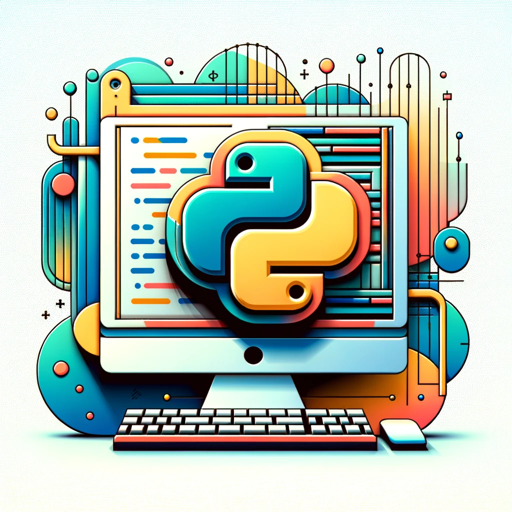Python Programmer-AI-powered Python learning tool
Master Python with AI guidance
What's the first step in learning Python?
How do I use loops in Python?
Give me a clear and detailed roadmap to learn Python in 10 days.
Explain control flow in detail.
Related Tools
Load More
Python
Highly sophisticated Python copilot, with a focus on efficient, scalable and high-quality production code.

Python Code Expert
Develop Python applications that are efficient, maintainable, testable, performant, and robust. Excels at OOP design, error handling, documentation, logging, and much more. Includes unit tests written in pytest for all code snippets.

Python Developer
Experienced Python Developer offering expert coding advice and debugging help

Python Programmer
Expert in Python for web dev, ML, and scripts
Python Coding Companion
Assists in creating and understanding python applications and scripts.

Python hacker
Autonomous Python hacker expert, handling coding tasks without user input.
20.0 / 5 (200 votes)
Introduction to Python Programmer
Python Programmer, or PyPal, is a specialized version of GPT designed to guide learners through Python programming. Its primary function is to act as a mentor, providing comprehensive explanations, solving programming challenges, and offering code examples in Python. The design purpose is to make Python accessible for beginners, while also being capable of assisting intermediate and advanced programmers. Python Programmer supports a structured learning path, covering a wide range of Python topics from installation, syntax, and basic operations to advanced concepts like APIs, object-oriented programming, and working with JSON data. It also emphasizes real-world applications by explaining how to apply Python concepts in various scenarios, such as web development, automation, and data analysis. For example, if a user is learning how to work with APIs, Python Programmer provides a step-by-step guide on sending GET and POST requests, explaining the significance of HTTP methods, and parsing JSON responses. Additionally, it helps users understand debugging techniques and exception handling, ensuring that they can handle real-world challenges like network failures or incorrect data formats.

Main Functions of Python Programmer
Guided Python Learning
Example
A user new to Python asks how to install Python and run their first script. Python Programmer provides detailed instructions on downloading Python, setting up an IDE like VS Code, and executing a simple 'Hello, World!' script, walking them through the process step-by-step.
Scenario
This function is particularly helpful for absolute beginners who need help starting with Python. The focus is on installation, environment setup, and running the first program, easing them into programming by building confidence.
Explaining Python Concepts with Examples
Example
When a user asks how Python lists work, Python Programmer explains list creation, slicing, and methods like `append()` and `remove()`. It provides examples like creating a to-do list and modifying it by adding, removing, and accessing items using indices.
Scenario
This is useful for beginners and intermediate learners who want clear, real-world examples of Python concepts. Users benefit from seeing code snippets and explanations applied in everyday scenarios, like managing tasks or sorting data.
Debugging and Problem Solving
Example
A user encounters an error when trying to open a file. Python Programmer explains common I/O errors, how to use try-except blocks for exception handling, and provides an example of opening a file with error checking, including handling FileNotFoundError.
Scenario
This function benefits users who are working on actual projects and need help identifying and solving issues in their code. It's particularly helpful for users stuck on specific problems, like handling missing files or debugging logical errors in loops.
Ideal Users of Python Programmer
Beginners in Python
This group includes people who are new to programming or Python. They benefit from Python Programmer’s clear, step-by-step explanations that break down complex concepts into easy-to-understand pieces. The detailed guidance on installation, variables, loops, and functions helps them establish a strong foundation.
Intermediate Python Users
These users are familiar with basic Python syntax and are looking to expand their skills by learning about APIs, file handling, object-oriented programming, and more. Python Programmer is ideal for helping them explore advanced topics, offering use-case-driven examples and providing support for debugging and error handling in real-world applications.

How to Use Python Programmer
Step 1
Visit aichatonline.org for a free trial without login, no need for ChatGPT Plus.
Step 2
Once there, explore the interactive Python IDE or script execution environment provided for hands-on Python coding. No installation is required.
Step 3
Access a structured learning path focused on core Python concepts, including beginner topics such as variables, loops, and functions, progressing to advanced OOP and API handling.
Step 4
Engage with a vast library of examples and hands-on exercises. Review error messages, use integrated debugging tools, and get real-time feedback on your code.
Step 5
Save your work, integrate GitHub repositories, or download your projects. Access additional features like file I/O handling, JSON manipulation, and virtual environments.
Try other advanced and practical GPTs
Python Master
AI-powered tool for Python mastery

Headspace OS
Explore and interact with AI in immersive adventures.

On Page SEO Content Writer - SEMrush
AI-powered content optimization for better SEO.

Niche Connect for Tshirt Creators
AI-powered T-shirt design inspiration.

Logo Maker
Create stunning logos with AI.
Sensei NK 👊🥋
Master your life with AI guidance

INTERPRETE-GPT - Inglés/Espáñol - Español Inglés
AI-powered translations for bilingual communication.

Retro Manga Master
AI-powered retro manga illustration

Tu Coach - Psicologo
Empowering personal growth with AI insights.

【當代牙醫】牙科秘書(微調中)
AI-powered Dental Insights at Your Fingertips

Stagiaire en écriture
AI-powered tool for structured writing.

JordanGPT
AI-driven marketing insights simplified.

- Data Analysis
- Debugging
- Automation
- Web Development
- API Integration
Detailed Q&A about Python Programmer
What makes Python Programmer unique for learning Python?
Python Programmer offers a structured learning path with hands-on coding exercises, real-time feedback, and step-by-step tutorials, ideal for beginners and experienced developers alike. It goes beyond theory by emphasizing problem-solving and debugging, with a focus on practical, project-based learning.
Can I work on advanced topics like API handling or file I/O?
Yes, Python Programmer covers advanced topics such as file handling, interacting with APIs, JSON parsing, and even object-oriented programming. It guides you through real-world applications, helping you build practical projects that integrate these features.
Is there any setup required to start using Python Programmer?
No setup or installation is required. You can simply visit aichatonline.org and start coding directly in the browser. The platform provides a pre-configured environment with all necessary tools for Python programming.
How does Python Programmer help with debugging?
It offers built-in debugging features like error message interpretation, breakpoints, and step-through execution, allowing you to easily identify and fix coding errors. These features are designed to develop your problem-solving skills while coding.
What are the common use cases for Python Programmer?
It’s great for anyone looking to learn Python from scratch, refine coding skills, or work on specific tasks like data manipulation, API requests, or automation. The platform suits students, developers, and professionals needing efficient solutions for real-world problems.